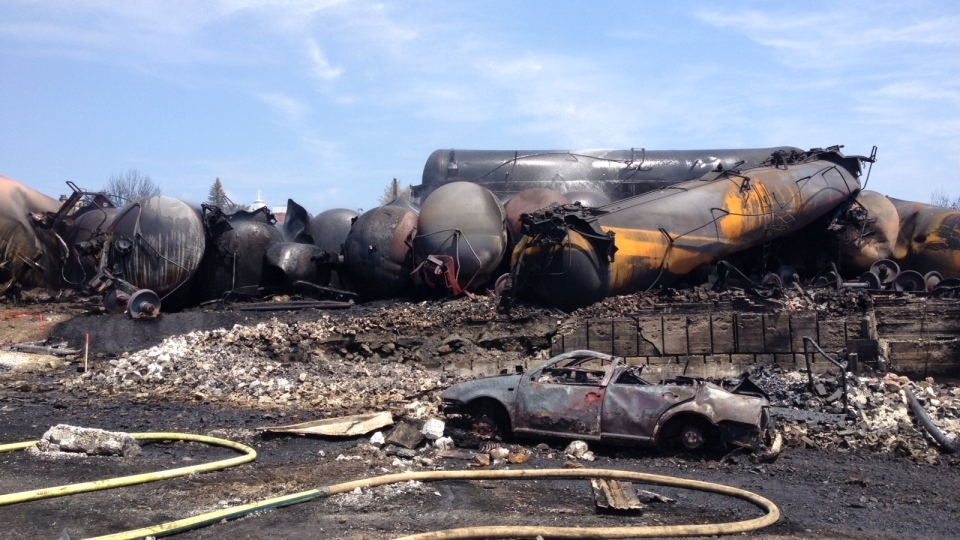
Tragedy Touches Lac-Mégantic
Just over a week ago, the picturesque Quebec town of Lac-Mégantic entered the public lexicon for all the wrong reasons. On Saturday, July 6, at 1:14 a.m., an unmanned runaway freight train belonging to the Montreal, Maine & Atlantic (MMA) Railway Ltd. derailed in the heart of the town. But this was no ordinary derailment. The train was 1.5 kilometers long and consisted of 73 cars, all but one of which were carrying crude oil from North Dakota’s Bakken region bound for an oil refinery in New Brunswick. The runaway train entered the town at a speed of 101 km/h without any warning — almost 10 times the maximum safe speed of 10 km/h — and upon reaching the curve in the tracks behind the main business district of Lac-Mégantic, many of its tanker cars and their highly flammable cargo derailed. They piled up like a gigantic iron accordion, exploding into flames on impact and quickly turning the heart of Lac-Mégantic into an unimaginable inferno.
Almost 40 buildings were instantly destroyed and dozens of residents were killed, many of whom were likely vaporized by the extreme heat from the explosions and subsequent fires. To date, 33 bodies have been recovered from the destruction and at least 17 more individuals remain missing and are presumed dead.
The scene was set for tragedy when, around 11 p.m. on Friday, July 5, more than two hours before the accident, the ill-fated train’s engineer parked the train on the mainline for an overnight stopover in Nantes, some 10 kilometers up track and also uphill from Lac-Mégantic. At that time, the engineer’s shift for the night was over. He took a cab to a hotel in Lac-Mégantic to sleep as the train sat on the tracks awaiting his replacement who would guide it further along its way to the New Brunswick refinery. As is the standard (and required) operating procedure, one of the train’s locomotive engines sat idling overnight. However, shortly after the engineer’s departure, smoke from what turned out to be a minor fire caused by a ruptured fuel or oil line in the sole running locomotive caught the attention of nearby residents of Nantes. That fire was promptly extinguished by local firemen. In putting out the fire, the firemen may have turned off the power to the locomotive. This may have been the true starting point for the chain of events that would ultimately result in catastrophe because, in order to keep the entire train’s airbrake system functioning, at least one locomotive must be running at all times. Without that one engine running, there would be no power to provide the pressurized air that maintains the air braking system itself.
That said, it is important to note that the airbrake system is not the sole braking system used to prevent a parked train from moving. All trains still use manually-set handbrakes as well. Each car has a handbrake. And, when a train is left unattended, whether overnight or just momentarily, the train’s crew must apply numerous handbrakes. Herein likely lies the answer to the mystery as to how and why the train began its deadly roll downhill towards its unscheduled final destination in Lac-Mégantic.
The key question in discovering why the accident occurred will likely be the following: did the engineer apply a sufficient number of handbrakes to keep the train stationary on the track’s downhill grade of 1.2%? But before an answer to that question can be found, it must be noted that the phrase “sufficient number of handbrakes” can best be described as subjective. This is because there is no cast-in-stone rule which determines how many handbrakes on any given train could be considered sufficient. While many railroaders use the so-called “10% plus two rule,” which stipulates that a sufficient number of handbrakes to prevent a train from moving can be achieved by applying the handbrakes on 10% of the cars making up the train plus an additional two cars, there are no hard and fast rules on this subject. In other words, what would be deemed a sufficient number of handbrakes on any given train often differs from one railway to another and from one crew to another.

Shortly after the accident, MMA Chairman Edward Burkhardt stressed the fact that, as far as he knew, the engineer had indeed adequately secured the train for its overnight stop, despite the track’s downhill grade of 1.2%. However, Burkhardt has since claimed that a total of 11 handbrakes needed to be activated to prevent the train from starting its deadly descent into Lac-Mégantic, and that the accident itself indicates that the engineer failed to do this before leaving the train unattended overnight. Determining whether or not the engineer did set the required 11 handbrakes will not be an easy task, given the scope and scale of the destruction on the ground in Lac-Mégantic. However, the locomotive’s event data recorder should be able to help clarify one aspect of the handbrake mystery.
The event data recorder will allow investigators to match the locomotive engine’s mechanical and instrumental performance with the timing of events following the train’s being secured for the night and preceding the outbreak of the minor fuel line fire and the engine’s possible powering down by Nantes’ local firemen. The preservation of such information would allow investigators to judge whether or not the engineer took any action indicative of testing the train’s handbrakes prior to turning in for the night. After setting what is deemed to be the appropriate number of handbrakes on a train, engineers are required to test the effectiveness of their handbrakes by trying to start the train and move it either forwards or backwards. Should the train move forwards or backwards while the throttle is depressed, an insufficient number of handbrakes has been set. The engineer must apply more handbrakes and then try the test again. It is only when the train cannot move under power that the test has been passed and the train truly secured. The event data recorder should indicate whether or not the handbrakes (sufficient in number) were tested in this manner before the train’s throttle was placed in its idle position and before the engineer called it a night.
Quite aside from the root cause for the runaway train, the accident itself has drawn public attention to the resurgence of the practice of shipping oil by rail. Because the volume of oil waiting to be brought to market from Canada’s oilsands as well as from the vast shale oil fields in North Dakota and Montana far exceeds the existing pipeline capacity and because the costs (both financial and regulatory) associated with expanding existing pipeline capacity have increased substantially (as has the virulence of organized environmental opposition to such projects), the volume of oil and petroleum products shipped by rail has increased markedly over the past few years. For instance, according to Statistics Canada, the number of Canadian railcars delivering crude oil or other petroleum products has doubled between April 2012 and April 2013. In April 2012, 7,194 railcars were used to deliver Canadian petroleum products. By April 2013, 14,217 railcars were used to deliver Canadian petroleum products to refineries and, ultimately, to market.
But it is when we look south of the border that we see more clearly the increasing importance of shipping oil by rail. In the United States, during the first half of this year alone, 355,933 carloads of oil were shipped by rail compared to just 5,358 carloads during the first half of 2009. Even so, with a combined Canadian and American oil production of some 11.26 million barrels per day, data reveals that less than 8% of North American oil was brought to market by rail during the first half of 2013.
Sadly, the tragic accident in Lac-Mégantic is now being harnessed by those on both the left and right of the political spectrum in an attempt to further their own political agendas. On the left, environmentalists are urging Canadians to re-examine and ultimately — but unrealistically — abandon fossil fuels not only because of their environmental impact but also their supposedly inherent risks to mankind as witnessed by the trail of destruction left behind in Lac-Mégantic. Also from left of the aisle, Thomas Mulcair, the Leader of the New Democratic Party (NDP) and the Leader of Her Majesty’s Loyal Opposition, has spuriously claimed that the accident could have been related to “public safety-related” spending cuts made by Stephen Harper’s Conservative government. On the right, advocates of the seemingly politically-toxic topic of pipeline expansion are claiming that the accident in Lac-Mégantic highlights the pressing need to greenlight present and future pipeline projects, given that shipping oil by pipeline generally results in fewer accidents than shipping oil by rail. However, data has shown that, while oil delivered by pipeline may indeed experience fewer accidents (and therefore spills) than oil delivered by rail, pipeline spills tend to release a greater volume of oil than rail-related spills.
Rhetoric aside, neither the tragic accident in Lac-Mégantic nor its probable regulatory fallout will fully satisfy the vested interests on the left or right of the political spectrum. While the derailment may marginally slow the expansion of shipping oil by rail and usher in the replacement of the widely used, but prone-to-rupture-upon-impact, Class 111A tank cars with safer and stronger tank cars constructed of thicker tank shells, the need for oil to produce everything from gasoline to plastic patio furniture will ensure that the oil trains keep rolling above ground and the pipelines keep flowing below ground.
Top Photo: Bell Media









